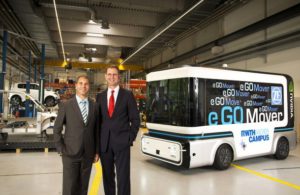Six Levels of Autonomous Driving and the Role of Artificial Intelligence
Artificial Intelligence, Machine Learning and Deep Learning are all terms referring to the performance of tasks normally requiring human intelligence. One of these tasks might still be driving a car, but how long does it take to get to autonomous cars and what kind of approaches in the field of artificial intelligence are already available?
To answer these questions the different levels of autonomous driving need to be regarded as well as the autonomous cars already marketed and their underlying technologies.
The Six Level of Autonomous Driving
SAE International and the National Highway Traffic Safety Administration (NHTSA) within the US Department of Transportation committed themselves to the definition of “six levels of driving automation”(Reference). The levels are numbered from 0 to 5 and represent the progress from no automation to full automation. The levels can be divided into two sections, 0 to 2 represent levels, where the human driver is monitoring the driving environment and 3 to 5 encapsulate levels, where the monitoring is done by the automated driving system. [1]
Level 0 also referred to no automation, describes driving under full control of a human driver, but the system can be enhanced with warning and intervention instruments. Level 1 is titled driver assistance, where specific functions, like either steering or accelerating and decelerating can be carried out automatically by the system while the human driver still has control over the car. Level 2 a partial automation of the driving system is achieved, which means multiple functions as the ones mentioned above can be automated. Combined with gathered surrounding information helpful tasks like cruise control and lane centering can be achieved, while the driver is still in charge to control the vehicle at any time. [1][2]
Now a shift is happening, the so called dynamic driving task, which sums up all operational and tactical aspects, gets automated. In level 3 the conditional automation is achieved and the driver is only required to take control if the system requests to intervene. The driver’s monitoring of the environment does not have to be as strict as in previous levels. In the high automation level 4 no fallback performance of the driver is required, while the system is monitoring the environment and performing all safety-critical driving functions. The last restriction compared to level 5 is it might not be applicable to every driving mode or scenario. The full automation in level 5 equals the performance of a human driver, who can manage to drive in all road and environment conditions, for instance off-road. [1][2]
The most difficult but also most important obstacle to overcome is to automate the dynamic driving task. It sums up all operational and tactical, but no strategical tasks a driver is doing. SAE International describes braking, steering, monitoring and accelerating as operational tasks, while the usage of signals, decision making to change lanes and responding to events are categorized as tactical tasks. The transmission between not automated and automated dynamic driving task takes place between the second and third autonomy level. [2]
By having a closer look at what operational and tactical driving tasks include the necessity of AI-Technology gets obvious.
“Autonomous” Car Technologies
To give an insight on what is happening in the autonomous car driving market right now I want to quickly outline three different projects.
The first level 3 car for production was just introduced by Audi, their new A8. It enables drivers to principally, dependent on the national law, focus on something else than the street and driving environment although they have to be able to take over the control if necessary and requested by the driving system. Therefor Audi introduced their Audi AI system, with an object detection and a physical maneuvering algorithm. [3][4]
Drive.ai a startup based in Mountain View approaches the mastering of autonomous cars strictly with deep learning from a holistic perspective. Deep learning based on neural networks is able to recognize patterns similar to humans and by that nuances in behavior can be developed, not possible in rule-based systems. One of the advantages they see in deep learning, is that systems can deal with ambiguity and even improvise, which is where robotic approaches lack ability. [5]

These are a few projects pathing the way to Gartner’s forecast of 200 to 250 million cars on autonomy level 3 in the 2020s. [6]
To conclude and outline the importance of AI-Technology to literally drive the development of autonomous cars I want to cite Sameep Tandon, CEO of drive.ai:
“If you look at the long-term possibilities of these algorithms and how people are going to build [self-driving cars] in the future, having a learning system just makes the most sense. There’s so much complication in driving, there are so many things that are nuanced and hard, that if you have to do this in ways that aren’t learned, then you’re never going to get these cars out there.”[5]
References:
[1] http://www.techrepublic.com/article/autonomous-driving-levels-0-to-5-understanding-the-differences/
[2] http://www.sae.org/misc/pdfs/automated_driving.pdf
[4] https://www.engadget.com/2017/07/11/audi-introduces-its-semi-autonomous-a8/
